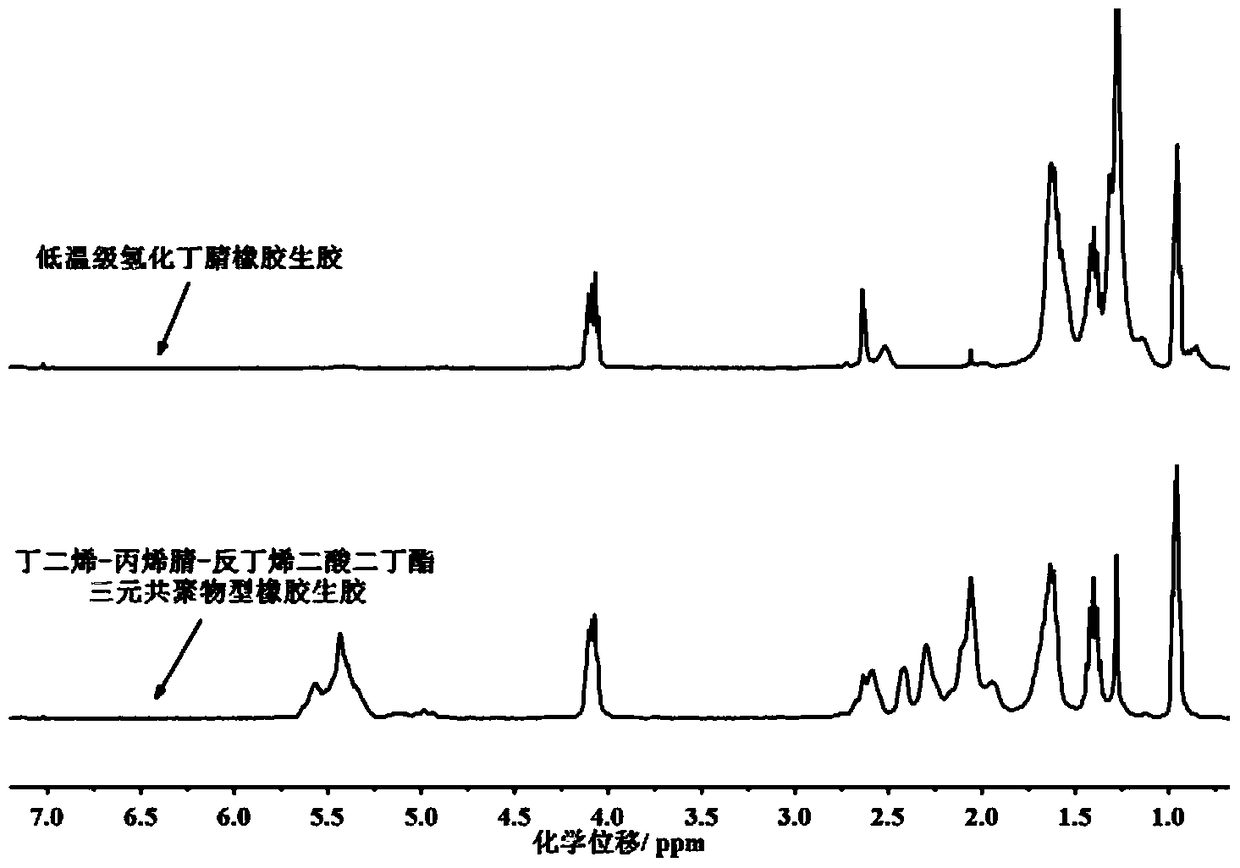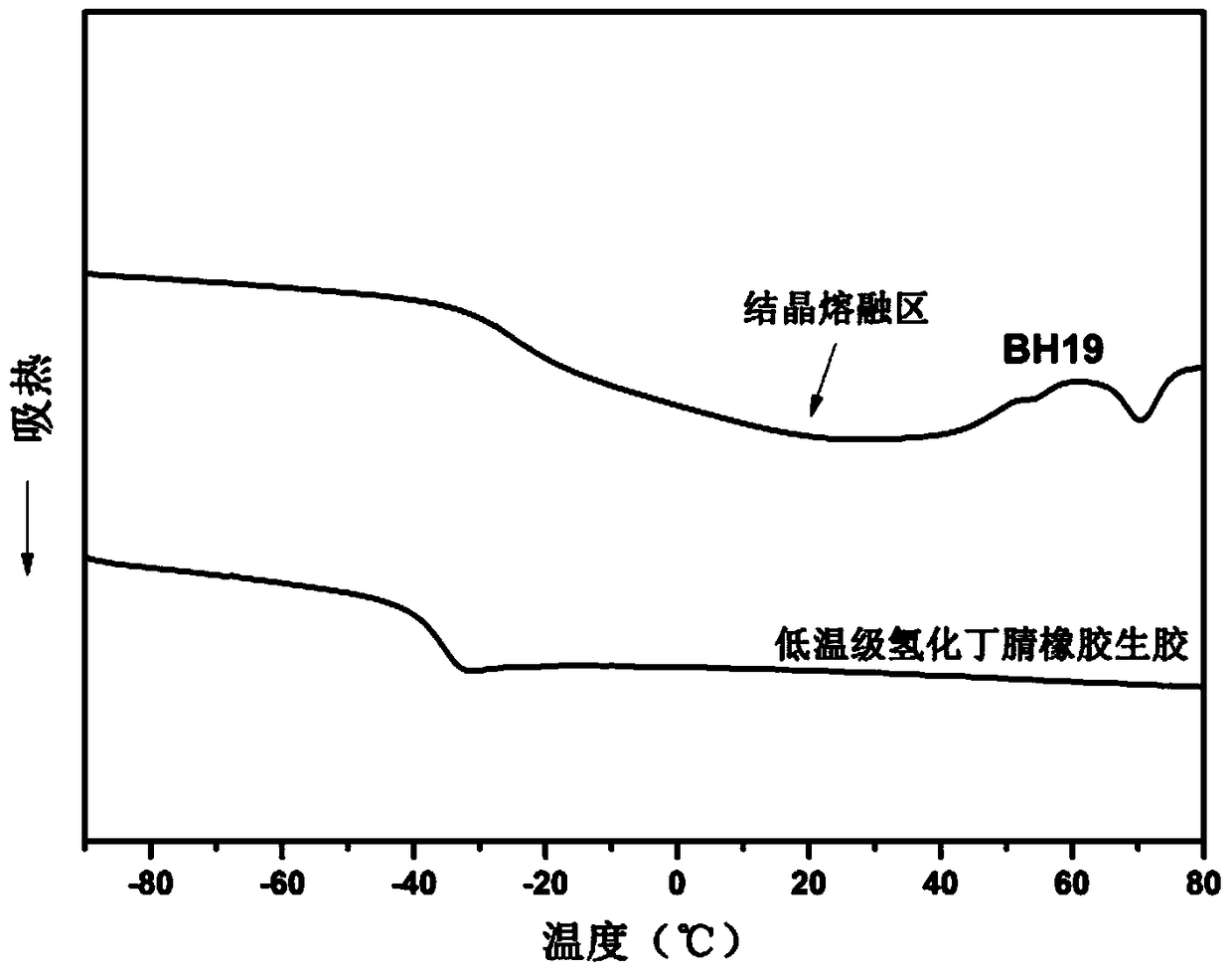A kind of low-temperature grade hydrogenated nitrile rubber raw rubber and preparation method thereof
A hydrogenated nitrile-butadiene rubber and low-temperature technology, applied in the field of modified nitrile-butadiene rubber and its preparation, can solve problems such as unreported, and achieve the effects of high application value, good oil resistance and broad development prospects
- Summary
- Abstract
- Description
- Claims
- Application Information
AI Technical Summary
Problems solved by technology
Method used
Image
Examples
Embodiment 1
[0033] In a 5L reactor, add 192g of butadiene, 72g of acrylonitrile, 216g of dibutyl fumarate, 960g of deionized water, 7.20g of sodium linoleate soap, 7.20g of disproportionated potassium rosinate soap, and 1.12g of phosphoric acid , Potassium hydroxide 1.91g, ethylenediaminetetraacetic acid 0.14g, sodium dinaphthalene sulfonate 0.69g, sodium ferric edetate 0.07g, sodium formaldehyde sulfoxylate 0.10g, tertiary dodecyl mercaptan 1.20 g, stir and mix evenly, then add 0.21g of sodium dithionite and 0.17g of p-menthane to the reaction kettle, adjust the temperature to 8°C, and react for 6h to obtain butadiene-acrylonitrile-fumaric acid di Butyl ester copolymer latex;
[0034] Pour the latex into a calcium chloride solution with a mass fraction of 3% to break the emulsion, and dry it in a vacuum oven at 50°C to obtain butadiene-acrylonitrile-dibutyl fumarate terpolymer rubber raw rubber. The content and molecular weight of each component in the copolymer, the results are listed ...
Embodiment 2
[0037] In a 5L reactor, add 192g of butadiene, 72g of acrylonitrile, 216g of dibutyl fumarate, 960g of deionized water, 7.20g of sodium linoleate soap, 7.20g of disproportionated potassium rosinate soap, and 1.12g of phosphoric acid , potassium hydroxide 1.91g, ethylenediaminetetraacetic acid 0.14g, sodium dinaphthalene sulfonate 0.69g, sodium iron edetate 0.07g, ferrous sulfate 0.10g, tertiary dodecyl mercaptan 1.20g , stir and mix evenly, then add 0.21g of sodium dithionite and 0.19g of p-menthane to the reaction kettle, adjust the temperature to 8°C, and react for 6h to obtain butadiene-acrylonitrile-fumarate dibutyl Ester copolymer latex, pour the latex into a calcium chloride solution with a mass fraction of 3% to break the emulsion, and dry it in a vacuum oven at 50°C to obtain a butadiene-acrylonitrile-dibutyl fumarate terpolymer Type rubber raw rubber, the content and molecular weight of each component in the copolymer were measured, and the results are listed in Table...
Embodiment 3
[0040] In a 5L reactor, add 240g of butadiene, 72g of acrylonitrile, 168g of dibutyl fumarate, 960g of deionized water, 7.20g of sodium linoleate soap, 7.20g of sodium dodecylbenzenesulfonate, Phosphoric acid 1.12g, potassium hydroxide 1.91g, ethylenediaminetetraacetic acid 0.14g, sodium perinaphthalene sulfonate 0.69g, sodium iron edetate 0.07g, sodium formaldehyde sulfoxylate 0.20g, tertiary dodecyl 1.20g of mercaptan, stir and mix evenly, then add 0.21g of sodium dithionite and 0.19g of cumene hydroperoxide into the reaction kettle, adjust the temperature to 8°C, and react for 8h to obtain butadiene-acrylonitrile-trans-butene Dibutyl diacid copolymer type latex, pour the latex into a calcium chloride solution with a mass fraction of 3% to break the emulsion, and dry it in a vacuum oven at 50°C to obtain butadiene-acrylonitrile-fumarate dibutyl Terpolymer type rubber raw rubber, the content and molecular weight of each component in the copolymer were measured, and the result...
PUM
| Property | Measurement | Unit |
|---|---|---|
| glass transition temperature | aaaaa | aaaaa |
| glass transition temperature | aaaaa | aaaaa |
| polydispersity index | aaaaa | aaaaa |
Abstract
Description
Claims
Application Information
 Login to View More
Login to View More - R&D Engineer
- R&D Manager
- IP Professional
- Industry Leading Data Capabilities
- Powerful AI technology
- Patent DNA Extraction
Browse by: Latest US Patents, China's latest patents, Technical Efficacy Thesaurus, Application Domain, Technology Topic, Popular Technical Reports.
© 2024 PatSnap. All rights reserved.Legal|Privacy policy|Modern Slavery Act Transparency Statement|Sitemap|About US| Contact US: help@patsnap.com










